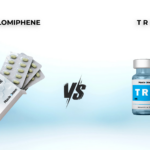
As men age, testosterone levels naturally decline, often leading to a myriad of symptoms ranging from decreased libido and energy levels to mood disturbances and reduced muscle mass. Traditionally, TRT has been the primary solution, involving the direct supplementation of testosterone to restore hormonal balance. Yet, amidst its widespread use, questions persist about potential long-term risks, such as suppression of natural testosterone production and cardiovascular concerns.
Enter clomiphene citrate, a selective estrogen receptor modulator (SERM) that operates by stimulating the body’s own production of testosterone. Widely regarded for its efficacy in treating female infertility by inducing ovulation, clomiphene’s off-label use in men has garnered attention as a potential alternative to TRT. By targeting the hypothalamus and pituitary glands, clomiphene prompts the release of follicle-stimulating hormone (FSH) and luteinizing hormone (LH), which in turn stimulate testicular testosterone production.
The debate between clomiphene and traditional TRT sparks intriguing discussions within the medical community and among men seeking hormonal optimization.
So, here it is! Enclomiphene vs TRT!
Key Takeaways
 While both Enclomiphene and TRT can increase testosterone levels, the latter will actually suppress your natural testosterone production, whereas the former will increase it
While both Enclomiphene and TRT can increase testosterone levels, the latter will actually suppress your natural testosterone production, whereas the former will increase it While both methods are remarkably safe at increasing testosterone levels, the former seems to be better when looking at sperm count
While both methods are remarkably safe at increasing testosterone levels, the former seems to be better when looking at sperm count Both are legal practices as long as you work with a GP, registered clinic, or primary hypogonadism specialist
Both are legal practices as long as you work with a GP, registered clinic, or primary hypogonadism specialist
What is Enclomiphene Citrate?
Enclomiphene is an isomer of clomiphene citrate, a medication initially developed to treat female infertility. Unlike its counterpart, clomiphene, which is a racemic mixture containing both enclomiphene and zuclomiphene, enclomiphene consists solely of the active enantiomer. Enclomiphene functions as a selective estrogen receptor modulator (SERM), primarily targeting the hypothalamus and pituitary glands in the brain.
By binding to estrogen receptors in these areas, enclomiphene blocks the negative feedback signals that would normally inhibit the release of follicle-stimulating hormone (FSH) and luteinizing hormone (LH).
This mechanism ultimately leads to an increase in the production of testosterone by the testes. Enclomiphene’s ability to stimulate the body’s own testosterone production without directly supplementing with exogenous hormones makes it an attractive option for men seeking treatment for testosterone deficiency, offering potential benefits in maintaining natural hormone balance and fertility.
History of Enclomiphene
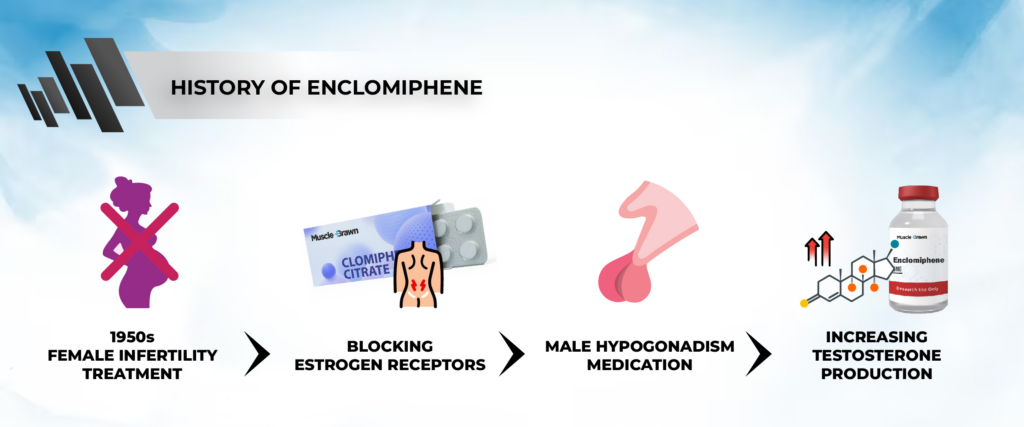
Enclomiphene emerged from the development of its predecessor, clomiphene citrate, synthesized in the late 1950s for female infertility treatment by blocking estrogen receptors.
Clinical trials revealed increased testosterone levels in men, sparking interest in its use for male hypogonadism. However, clomiphene contains two enantiomers, with zuclomiphene causing estrogenic side effects.
Researchers isolated enclomiphene, the active enantiomer, to create a medication specifically for male hypogonadism. Enclomiphene selectively blocks estrogen receptors in the hypothalamus, stimulating gonadotropin-releasing hormone and subsequent follicle-stimulating hormone and luteinizing hormone release, thus increasing testosterone production.
This journey underscores the synergy between scientific discovery, clinical observation, and pharmaceutical innovation in hormonal health. Enclomiphene presents a promising alternative or adjunctive therapy to traditional testosterone replacement, offering potential benefits in efficacy and safety for men seeking hormonal optimization.
Benefits of Enclomiphene
- Stimulates Testosterone Production: Enclomiphene selectively blocks estrogen receptors in the hypothalamus, promoting the release of gonadotropin-releasing hormone (GnRH) and subsequent secretion of follicle-stimulating hormone (FSH) and luteinizing hormone (LH), thereby increasing endogenous testosterone production.
- Maintains Natural Hormone Balance: Unlike traditional testosterone replacement therapy (TRT), which directly supplements exogenous testosterone, enclomiphene works by stimulating the body’s own testosterone production, potentially avoiding the suppression of natural testosterone production and preserving hormonal balance.
- Potential Safety Profile: By targeting estrogen receptors specifically in the hypothalamus, enclomiphene may offer a more favorable side effect profile compared to TRT, particularly in terms of minimizing estrogenic side effects such as gynecomastia (enlargement of breast tissue) and preserving fertility.
What is Testosterone Replacement Therapy (TRT)?
Testosterone Replacement Therapy (TRT) is a medical treatment designed to alleviate symptoms associated with low testosterone levels, a condition known as hypogonadism. TRT involves administering exogenous testosterone to supplement or replace the body’s natural testosterone production.
This can be achieved through various delivery methods such as injections, topical gels, patches, or pellets implanted under the skin. By restoring testosterone levels to within the normal range, TRT aims to improve symptoms such as fatigue, reduced libido, erectile dysfunction, mood disturbances, and decreased muscle mass.
Treatment protocols are typically tailored to individual needs, with healthcare providers monitoring testosterone levels regularly to ensure efficacy and safety. TRT has been extensively studied and is considered a standard treatment option for men with clinically diagnosed hypogonadism.
History of TRT
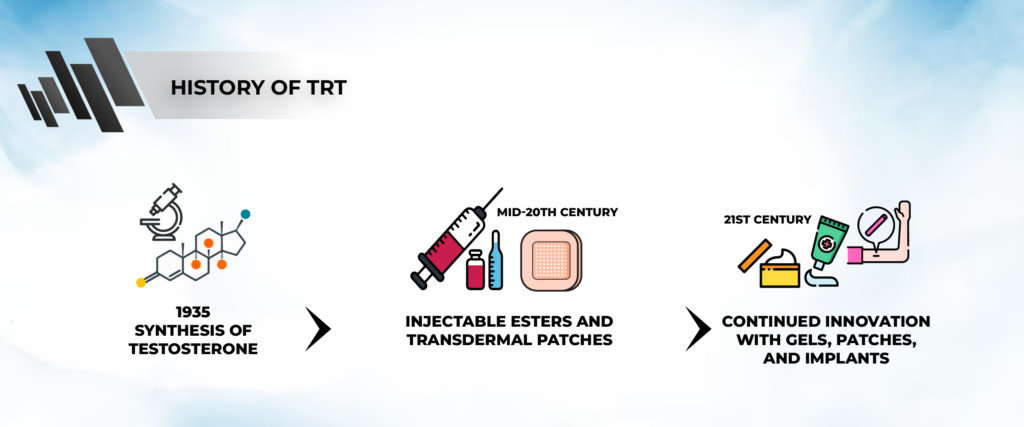
The history of Testosterone Replacement Therapy (TRT) dates back to the late 19th century when researchers began exploring testicular extracts for their physiological effects.
The synthesis of testosterone in 1935 marked a significant milestone, enabling further investigation into hormone replacement therapies. Early formulations lacked standardization, but by the mid-20th century, advancements led to more refined treatments like injectable esters and transdermal patches.
The 21st century saw continued innovation with gels, patches, and implants, alongside the establishment of clinical guidelines. Despite its therapeutic benefits for hypogonadism, TRT remains subject to debates regarding risks and appropriate usage, including concerns about cardiovascular health and abuse for performance enhancement. Nonetheless, TRT stands as a testament to the ongoing interplay between scientific discovery, medical progress, and the pursuit of optimal hormonal health.
Forms of TRT
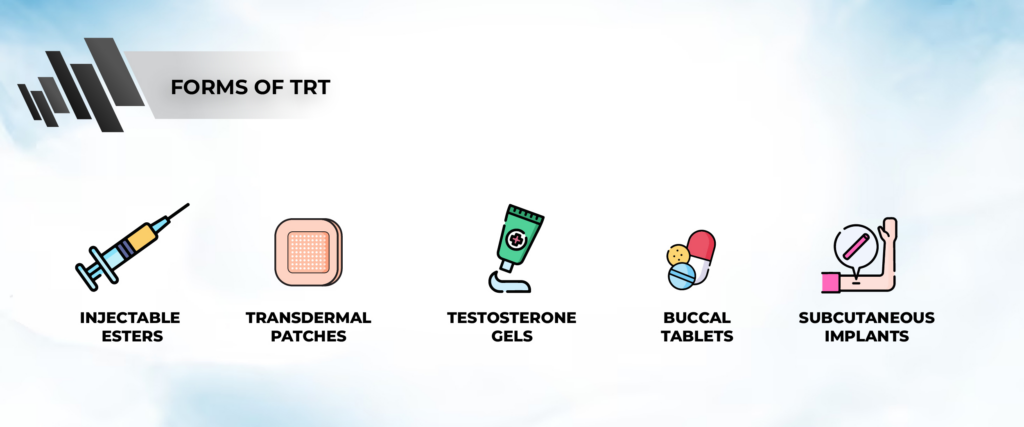
- Injectable Testosterone Esters: Injectable testosterone esters, such as testosterone enanthate and testosterone cypionate, are administered via intramuscular injections. Their biggest benefit lies in their long duration of action, typically requiring injections every 1 to 2 weeks. This provides stable testosterone levels and convenient dosing schedules for patients.
- Transdermal Patches: Transdermal patches deliver testosterone through the skin, allowing for continuous absorption over 24 hours. Their main advantage is convenience, as patients can apply the patch once daily and avoid the need for frequent injections. Patches also provide steady testosterone levels, minimizing peaks and troughs compared to oral medications.
- Testosterone Gels: Testosterone gels, applied topically to the skin, offer ease of use and flexibility in dosing. They allow for precise dosing adjustments and convenient application, making them suitable for patients who prefer non-invasive treatments. Gels also provide consistent absorption, maintaining stable testosterone levels throughout the day.
- Buccal Tablets: Buccal testosterone tablets are placed against the gumline, where testosterone is absorbed directly into the bloodstream through the oral mucosa. Their main benefit is rapid absorption, offering quick relief of symptoms. Buccal tablets provide a discreet and convenient alternative to injections or gels for some patients.
- Subcutaneous Implants: Testosterone pellets are implanted under the skin, typically in the buttocks or abdomen, where they gradually release testosterone over several months. The main advantage of implants is their long-lasting effect, requiring fewer administrations compared to other methods. This makes them suitable for patients seeking a low-maintenance TRT option.
Benefits of TRT
- Symptom Relief: TRT effectively alleviates symptoms associated with low testosterone levels, such as fatigue, reduced libido, erectile dysfunction, mood disturbances, and decreased muscle mass. By restoring testosterone levels to within the normal range, TRT can significantly improve quality of life and overall well-being for individuals with hypogonadism.
- Improved Sexual Function: TRT can enhance sexual function by increasing libido, improving erectile function, and restoring sexual satisfaction. Many individuals experience a noticeable improvement in sexual desire and performance with TRT, leading to greater intimacy and satisfaction in relationships.
- Increased Muscle Mass and Strength: Testosterone plays a crucial role in maintaining muscle mass and strength. TRT can help individuals build and preserve muscle mass, enhance physical performance, and improve exercise tolerance. This can be particularly beneficial for individuals looking to maintain an active lifestyle, prevent age-related muscle loss, or recover from injuries or illnesses that have led to muscle wasting.
Enclomiphene Citrate vs TRT
Increasing Testosterone
There is no doubt that TRT will increase your testosterone levels far more and stronger than any other method would. You’re literally replacing something that is missing rather than finding a way to somehow fix something. Thus, TRT will always come out on top.
However, there is a drawback to this. See, when you replace the testosterone, you shut off any and all ability to produce your own Test. So, Enclomiphene citrate wins that debate seeing as it will increase your ability to produce test naturally.
Ability to Increase Sperm Count
It’s no secret that replacing your endogenous Test will not only reduce your own testosterone production, but also reduce your LH and FSH levels. But what about sperm count?
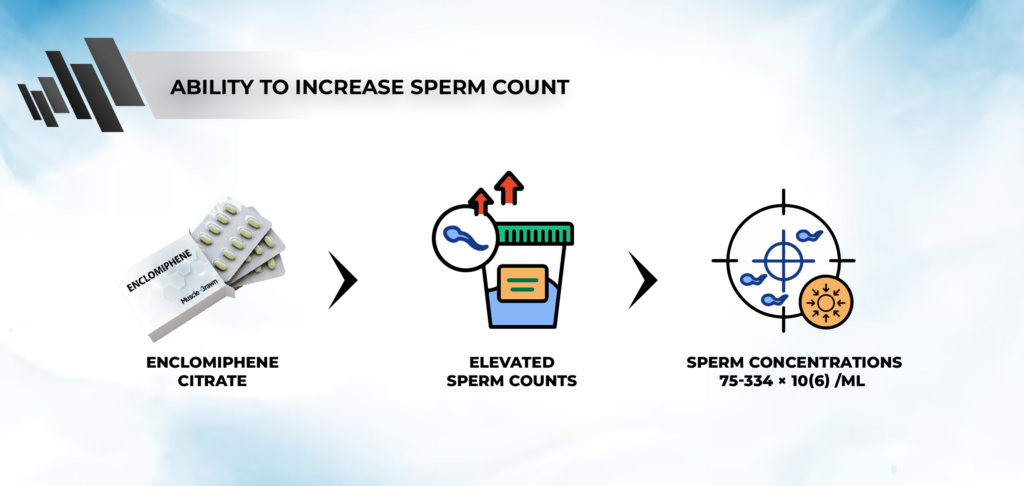
Well, let’s look at this quote from this study, “Testosterone as a contraceptive can suppress spermatogenesis and lead to azoospermia in 65% of normospermic men within 4 months of use. Cessation of exogenous testosterone will lead to the reversal of hormonally-induced azoospermia in 64% to 84% of men with a median time of about 110 days – All men in these studies recovered to baseline levels after cessation of therapy; however, it took up to 2 years for some men to recover. These studies were performed in a controlled setting for a clinical trial, with a limited duration of testosterone use. In actual practice, recovery may not be as pronounced.“
So… Testosterone replacement therapy will reduce sperm count. But what about Enclomiphene citrate? Well… Let’s look at this study, “Enclomiphene citrate elevated sperm counts in seven out of seven men at 3 months and six out of six men at 6 months with sperm concentrations in the 75-334 × 10(6) /mL range“. There is no doubt, Enclomiphene citrate is better for low testosterone AND sperm count, if both are important to you.
Estrogen Management
You may want more testosterone, but you don’t always WANT more estrogen. Well, Enclomiphene citrate is unlikely to increase estrogen – and even if it does, it’ll be well within normal levels. However, testosterone replacement therapy will and could increase estrogen far past what is normal levels. Excess synthetic testosterone will convert into more estrogen than a normal amount of Testosterone you produce.
Side Effects
Testosterone Replacement Therapy (TRT) involves administering exogenous testosterone to address hormonal imbalances in men. Potential side effects of TRT include acne due to increased oil production, fluid retention leading to bloating or swelling, gynecomastia resulting from an imbalance between testosterone and estrogen, testicular atrophy due to suppressed natural testosterone production, mood changes such as irritability or depression, and erythrocytosis which may increase the risk of blood clots.
Enclomiphene, a selective estrogen receptor modulator (SERM), stimulates natural testosterone production by acting on the hypothalamus and pituitary gland. Its potential side effects may include hot flashes, headaches, nausea, blurred vision, mood swings, and testosterone fluctuations.
Legality
Both of these compounds can be used under the guidance of a medical professional.
Where do I find Enclomiphene?
The best place we’ve come across Enclomiphne has to be with Fountain TRT.
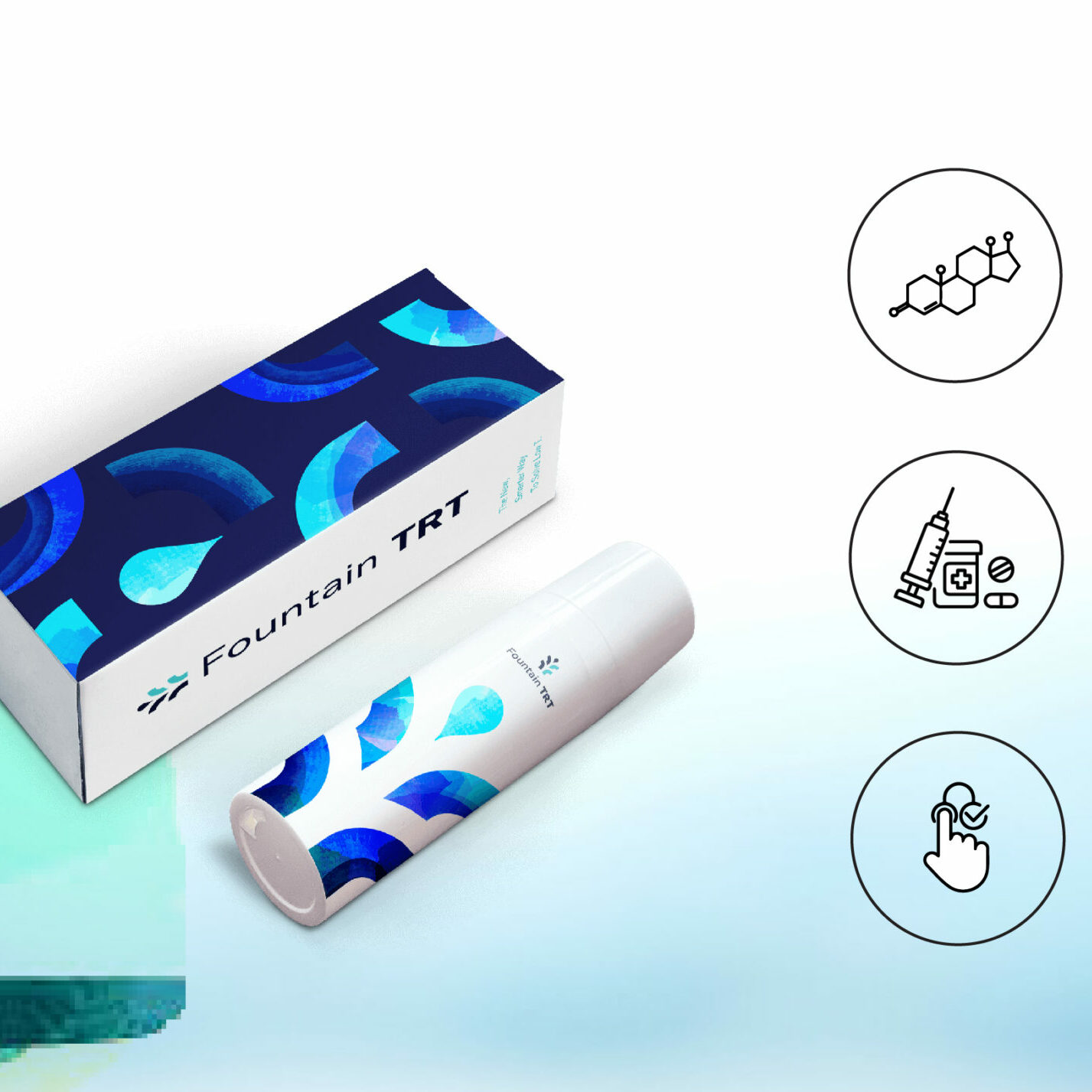
Get Enclomiphene Legally Prescribed Online
FountainTRT can prescribe you the perfect dose of enclomiphene and their affordable blood work will keep you dialed in the long term for NO extra cost.
Conclusion
Both of these medications hold significant benefits in the world of hypogonadism, each of which has it’s own ‘special’ benefits, as well as drawbacks. In the end, your specific method of addressing your low testosterone will depend on what your needs are and which side effects you wish to avoid. Overall, TRT is better for those who are perhaps no longer interested in having children, whereas Enclomiphene is best for those looking to keep sperm count high.
Is enclomiphene comparable to TRT?
Yes, seeing as both will increase your testosterone levels. However, the former will increase your natural testosterone levels whereas the latter will decrease natural production.
How much does enclomiphene raise testosterone?
Studies indicate it can increase low testosterone by upwards of 300%.
Does enclomiphene work for everyone?
No, it does not. This is why it is important to work with a medical expert that will guide you through the process and ensure you are on the right pathway to success.
When does enclomiphene kick in?
Subjects reported effects within the first 7 – 14 days.

 ? Testosterone
? Testosterone